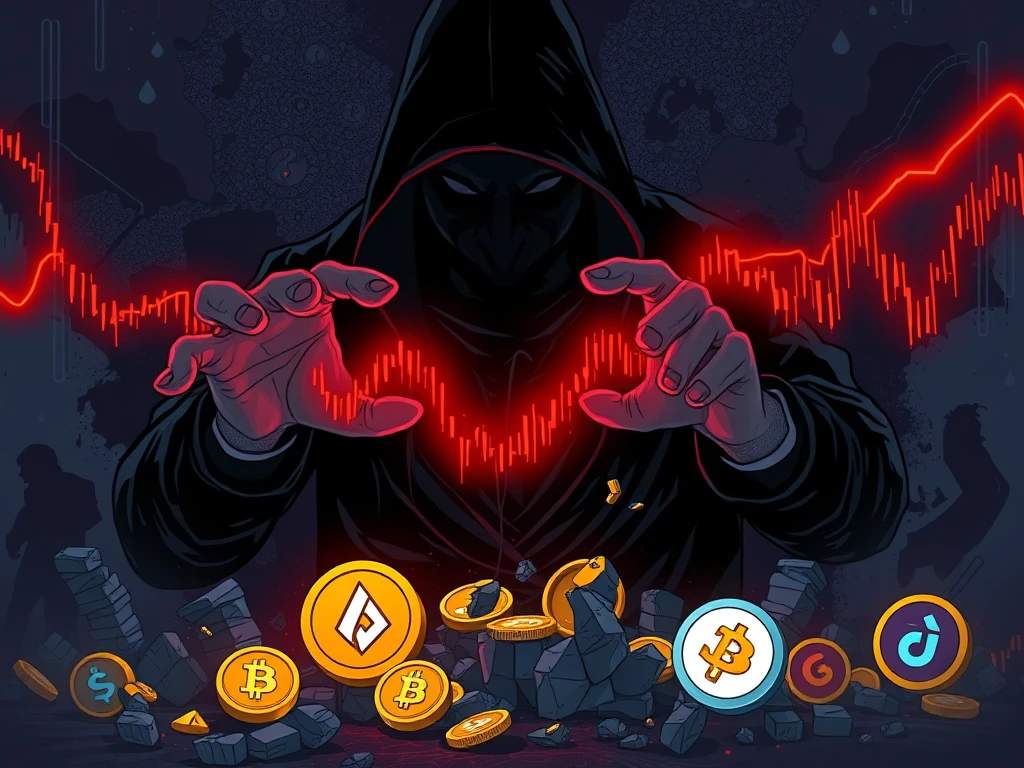Exposed: Predatory Market Maker Deals Crushing Crypto Projects

Are you invested in promising new crypto projects? You might want to understand a silent threat lurking in the shadows: market maker deals. While the right partnership can boost a crypto project to new heights, the wrong market maker deals are quietly becoming a death sentence for many. Specifically, the ‘loan option model’ is under scrutiny, with accusations that some predatory market makers are exploiting this structure to profit at the expense of the very projects they are supposed to support. Let’s dive into how these deals work and why they are causing so much concern in the crypto space.
What are Market Maker Deals and Why Do Crypto Projects Need Them?
Imagine launching a groundbreaking crypto token. To succeed, your token needs to be easily traded on exchanges. This is where market makers come in. A market maker’s role is to provide liquidity, ensuring there are always buyers and sellers for your token. They bridge the gap between project launch and widespread adoption, making your token accessible and tradable. Ideally, a market maker acts as a launchpad, paving the way for exchange listings and price stability. However, the crypto landscape isn’t always ideal, and certain types of market maker deals are proving to be more of a trap than a launchpad.
The Perilous ‘Loan Option Model’: A Death Spiral for Crypto Projects?
One particular type of agreement, the ‘loan option model,’ is raising alarm bells. Here’s how it typically unfolds:
- Token Loan: A crypto project lends a significant amount of its tokens to a market maker.
- Promise of Exchange Listings: In return, the market maker promises to use these tokens to create liquidity and secure listings on major cryptocurrency exchanges.
- Repayment Terms: Often, if exchange listings don’t materialize within a year, the market maker is obligated to return the tokens, sometimes at a pre-agreed higher price.
Sounds reasonable, right? Unfortunately, in practice, this model can become incredibly damaging. According to Ariel Givner, founder of Givner Law, the reality is often far from beneficial for the crypto project.
“How it works is that market makers essentially loan tokens from a project at a certain price. In exchange for those tokens, they essentially promise to get them on big exchanges,” Givner explained. “If they don’t, then within a year, they repay them back at a higher price.”
But here’s the catch – and the potential downfall.
The Devastating Playbook of Predatory Market Makers
Instead of using the loaned tokens to genuinely build liquidity and support the project, some market makers allegedly engage in a destructive tactic:
- Token Dump: They immediately sell off a large portion of the loaned tokens on the open market.
- Price Crater: This sudden sell-off creates significant downward pressure, causing the token’s price to plummet.
- Buy Back at Discount: Once the price has crashed, the market maker buys back the tokens at a much lower price, pocketing the difference as profit.
This strategy allows predatory market makers to enrich themselves while leaving the crypto project in ruins. “I haven’t seen any token really benefit from these market makers,” Givner stated, highlighting the severity of the issue. “I’m sure there are ethical ones, but the bigger ones I’ve seen just destroy charts.”
Who are the Key Players in Market Maker Deals?
Firms like DWF Labs and Wintermute are prominent names in the market-making arena. While these firms offer valuable services, it’s crucial for projects to understand the nuances of their proposed agreements, especially when loan option models are involved.
DWF Labs has stated that they do not rely on selling loaned assets to fund their operations, emphasizing their commitment to ecosystem growth. However, some industry observers have raised concerns regarding their trading practices. Wintermute, while not directly commenting on the loan option model in this context, has openly acknowledged that they are “in the business of making money by trading.”
Why Do Crypto Projects Fall for Predatory Market Maker Deals?
Jelle Buth, co-founder of market maker Enflux, points to “information arbitrage” as a key factor. Predatory market makers expertly present these deals as low-risk and high-reward, highlighting the benefits while downplaying the potential downsides.
“I call it information arbitrage, where the market maker very clearly understands the pros and cons of the deals but is able to put it such that it’s a benefit. What they say is, ‘It’s a free market maker; you don’t have to put up the capital as a project; we provide the capital; we provide the market-making services,’” Buth explained.
Many crypto projects, especially newer ones, lack the experience and expertise to fully grasp the risks associated with loan option deals. They may be swayed by the promise of “free” market-making services without realizing the potential for long-term damage to their token’s price and project’s reputation.
Identifying Red Flags in Market Maker Deals: What Should Crypto Projects Watch Out For?
To protect themselves, crypto projects must be diligent and informed when considering market maker deals, particularly loan option models. Jelle Buth advises projects to focus on key performance indicators (KPIs) related to liquidity quality. Before committing to any deal, projects should ask:
- Clear KPIs: Are the KPIs for liquidity clearly defined and measurable in the contract? Vague or missing KPIs are a major red flag.
- Order Book Depth: Will the deal result in genuine order book depth, indicating healthy and sustainable liquidity?
- Long-Term Incentives: Does the market maker have incentives to support the project’s long-term success, or is the deal structured for short-term profit at the project’s expense?
Kristiyan Slavev, co-founder of Web3 accelerator Delta3, echoes the grim reality: “We’ve worked with projects that were screwed over after the loan model. It’s exactly the same pattern. They give tokens, then they’re dumped. That’s pretty much what happens.” Numerous examples exist of projects that have suffered significant price drops after entering into loan option agreements.
| Project Outcome | Description |
|---|---|
| Price Tanked | Six projects reviewed that used loan option deals saw significant price declines. |
| Damaged Ecosystem | Projects were often left worse off than before the market maker agreement. |
Are All Market Maker Deals Destined for Disaster?
No, not all market maker deals are inherently harmful. The loan option model itself isn’t necessarily predatory. Its success or failure hinges on how it’s structured and managed. For larger, more established projects, the loan option model can even be beneficial. A listings advisor emphasized that project management of liquidity relationships is crucial. “I’ve seen a project with up to 11 market makers – about half using the loan model and the rest smaller firms,” they noted. “The token didn’t dump because the team knew how to manage price and balance the risk across multiple partners.”
Think of it like borrowing from a bank – different banks offer different terms. The key is understanding the terms and managing the relationship effectively. However, in the crypto world, information asymmetry often favors market makers, making it a “survival of the fittest” scenario.
The Role of Exchanges and Eroding Confidence
Arthur Cheong, founder of DeFiance Capital, raises a critical point about centralized exchanges (CEXs). He accuses them of turning a “blind eye” to artificial pricing driven by questionable market maker deals. This alleged complicity further erodes confidence in the altcoin market. However, the listings advisor argues that exchanges, especially tiered exchanges, are taking action against predatory market makers and projects engaging in suspicious activities. Exchanges may freeze accounts and conduct investigations when red flags are raised.
“While there is a close working relationship, there is no influence between the market maker and the exchange of what gets listed. Every exchange would have their own due diligence processes. And to be frank, depending on the tier of the exchange, there is no way that there would be such an arrangement,” the advisor stated.
The Retainer Model: A Safer Alternative for Crypto Projects?
A potential solution gaining traction is the “retainer model.” Instead of loaning tokens, projects pay a flat monthly fee to the market maker for clearly defined services. This model, while potentially more expensive upfront, aligns incentives for long-term collaboration and reduces the risk of token dumping.
Kristiyan Slavev advocates for the retainer model: “The retainer model is much better because that way, market makers have incentives to work with the projects long term. In a loan model, you get, like, a one-year contract; they give you the tokens, you dump the tokens, and then one year after that, you return the tokens. Completely worthless.”
The Gray Areas and the Need for Transparency
While the loan option model is described as “predatory,” Ariel Givner points out that these agreements are currently legal contracts. The crypto space, often referred to as the “Wild West,” still operates in a gray area regarding market manipulation, especially with tokens not classified as securities. However, increasing awareness and scrutiny are pushing the industry toward greater transparency and accountability.
The recent controversy surrounding Mantra’s OM token and allegations of a 90% price drop due to an expiring loan option deal with FalconX (which Mantra denied) highlights this growing awareness. Even when denied, these incidents fuel public suspicion and underscore the need for clearer understanding and regulation of market maker deals.
Conclusion: Navigating the Treacherous Waters of Market Maker Deals
The loan option model, while not inherently flawed, has become a double-edged sword in the crypto world. For crypto projects, especially smaller ones, navigating market maker deals requires extreme caution and due diligence. Understanding the risks of predatory market makers and exploring alternative models like the retainer model are crucial steps towards protecting project sustainability and investor confidence. Until greater transparency and accountability prevail, the ‘loan option model’ will remain a contentious and potentially dangerous aspect of the crypto market. Projects must prioritize informed decision-making and seek expert advice to avoid falling victim to these predatory market maker deals.
Are market maker deals essential for crypto liquidity or a source of manipulation? The answer, it seems, lies in understanding the fine print and demanding greater transparency.
#Bitcoin #Altcoin #Markets #Tokens #Liquidity #Features








